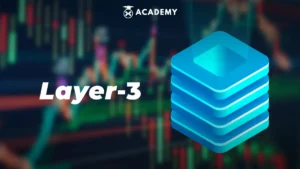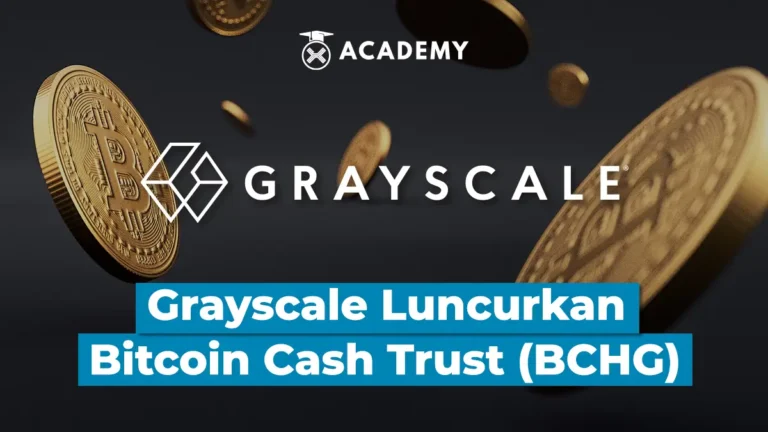Crypto and blockchain are two revolutionary technologies that have changed the way we understand and interact with financial systems, technology, and many other industries.
Blockchain itself is the basic technology that supports crypto and is the basis of this entire ecosystem. It is a decentralized digital ledger that records all cryptographic transactions that have ever taken place.
Meanwhile, layer 3 refers to the layer built on top of the basic blockchain, which is where further innovation and applications develop. This means that blockchain is not only a tool for transferring value but also a basis for a wide variety of solutions that can change various aspects of our lives.
So, to understand more about what Layer 3 is, how it works, its advantages and projects, and its potential and challenges, see the full review below.
What is Layer 3?
Basically, layer 3, also known as the “application layer” or “smart contract layer, is a stage above the basic blockchain that allows the development of more complex and well-programmed applications and protocols.
As alluded to above, this is a place where a lot of innovation and development takes place within the blockchain ecosystem.
One of the core components of Layer 3 is smart contracts, namely computer code that is executed automatically when the conditions specified in the contract are met. Besides that, layer 3 is also the basis for the development of DApps, which are decentralized applications that run on the blockchain.
Please note that the Decentralized Finance (DeFi) ecosystem mainly operates at Layer 3. Then, NFTs (non-fungible tokens), which represent unique ownership of digital assets, are also at Layer 3.
Furthermore, layer 3 focuses on interoperability between different blockchains. This means allowing different blockchains, which can use different technologies (e.g., Ethereum, Binance Smart Chain, Polkadot, etc.), to communicate and interact with each other.
In comparison, it is important to understand that layer 1 is the basic blockchain that provides basic crypto transaction services with a focus on security, decentralization, and consensus.
Meanwhile, layer 3 is the application layer that enables the development of more complex cryptographic applications.
Layer 1 focuses on basic value transfer, while layer 3 enables the development of various crypto applications, such as smart contracts, DApps, DeFi, and NFTs.
Layer 1 is simpler in its function, while Layer 3 has a much higher level of complexity because it deals with sophisticated application programming.
Major innovation in the blockchain ecosystem often occurs at Layer 3, with developers creating new applications and protocols that leverage the power of blockchain.
On the other hand, layer 3 depends on layer 1 for basic security and consensus. In this case, layer 1 provides the basis for all transactions that occur at layer 3.
How Layer 3 Works
It is important to understand that the way layer 3 works cannot be as simple as creating a new network on top of the layer 2 network. In an essay regarding layer 3, Vitalik Buterin wrote that there are limitations to “stacking” a new network on top of the existing network.
This might apply to a layer 2 network that is built on a layer 1 network, but the same thing will not apply to a layer 3 network that is built on a layer 2 network.
For example, rollup technology uses compression technology, where various data is collected and “rolled” into one. However, data that has been compressed cannot be combined and compressed again, so rollups on top of rollups are something that cannot happen.
However, creating a network above layer 2 with specific goals aligned with each specialty is something that can happen.
By using the layer 2 network as the basis, layer 3 does not need to build its own validator system. In this case, it can use layer 2’s validator network and use the security aspects of the protocol used, both rollup and zero-knowledge.
This is currently being done by one of the companies that focuses on developing layer 3 solutions, namely Starkware. Please note that layer 2 is used as a general-purpose scaling solution, but layer 3 has specific functionality.
Layer 3 can have functions that prioritize privacy, specific application performance, or other purposes that align with developer needs.
Advantages of Using Layer 3
After knowing the definition and how it works, now is the time to find out what the advantages of using Layer 3 are.
This is important to know because, later, it can help you understand how blockchain technology can be used more sophisticatedly and effectively. The following are some of the advantages of using Layer 3 that you need to know:
1. Scalability
By having multiple chains, each of which is dedicated and has separate resources, it is easier to overcome bottleneck problems in layer 2.
2. Privacy and Security
Layer 3 also allows developers to implement additional privacy layers on top of the base blockchain (Layer 1). This means that applications built at Layer 3 can provide a better level of privacy for users.
3. Customization
Layer 3 is known to provide greater flexibility in designing cryptographic applications. Developers can create highly customized smart contracts and dApps according to their needs or the needs of users.
4. Interoperability
One of the main advantages of Layer 3 lies in its ability to increase interoperability between different blockchains. This allows assets and data to move more freely between different blockchain networks, creating a more connected ecosystem.
Get to know Some Layer 3 Projects
Getting to know several Layer 3 projects is quite important because these projects play a central role in the development of the blockchain and crypto ecosystem.
By getting to know these projects, you can better understand the evolution of blockchain technology and participate more effectively in this ecosystem. The following are several layer 3 projects that are important to know:
-
ZK Stack
Through ZK Stack, the company Matter Labs is currently known to be developing a layer 3 concept. This project is in the form of a modular framework to create an independent zero-knowledge-based hyperchain (layer 3). The ZK Stack is based on the open-source code from the ZKSync Era Layer 2 network.
The ZK Stack will also provide freedom in selecting the data availability mode for developers, both for native tokens and decentralized sequencers.
It is known that this hyperchain will operate independently and depend on Ethereum regarding its security aspects.
This hyperchain will have support from hyperbridges that connect between hyperchains. That way, an ecosystem that is trustless, fast, and has low transaction costs will be created.
The following are a number of projects that are considered suitable for using Hyperchain from ZK Stack:
- dApps that require a lightweight sequencer with low sequencing latency
- Apps that can interact without the need to use trust assumptions as a link
- Closed private network, but still connected to the ecosystem
- Apps that use the native token as the system base token
Furthermore, from a security perspective, ZK Stack will use the ZK rollup technology from zkSync Era, which has been tested on the Ethereum network.
Layer 3 of the ZK Stack will ultimately not only offer an independent network that can be adapted to the needs of the development team but will also continue to inherit the security aspects of Ethereum’s layer 1.
-
Orbital Arbitrum
Being part of Arbitrum, Arbitrum Orbit allows developers to easily launch their own layer 3 ecosystem and requires no specific permissions. The Arbitrum Orbit Chain can be created on Arbitrum’s layer 2 network, Arbitrum One, or Arbitrum Nova.
If you choose Arbitrum One, which uses a rollup protocol, its layer 3 characteristics will prioritize security but still have a high level of scalability.
On the other hand, if you choose Arbitrum Nova, which uses the Anytrust protocol, layer 3 will focus on the level of scalability but sacrifice the level of security.
It is important to remember that layer 3 has characteristics in the sense that it can be adjusted according to the needs of the developer. Arbitrum Orbit also offers chains that can be customized according to a developer’s specific needs.
To accommodate further network modifications, Arbitrum will even be launching the Stylus soon. This update will allow developers to use non-EVM programming languages, such as Rust and C++.
Potential Future Challenges of Layer 3

Discussion of various types of layer 3 challenges that need to be known, including:
Understanding the potential challenges of Layer 3 in the future is also quite important. The reason is that this can help developers, investors, and users prepare themselves and overcome obstacles that may arise.
By understanding the potential challenges that may arise in the future, the blockchain ecosystem can be better prepared to address them. Here are some potential challenges for Layer 3 in the future that you need to know, namely:
1. Interoperability
To ensure connectivity between layer 3 networks, a clearer pattern or mechanism structure is still needed. Until now, layer 3 developers have been trying to find a solution for interoperability between networks.
2.Security
The mechanism for how validators work at layer 3 still follows the technology used at layer 2. This means that exploring and developing rollups or ZK technology is important in ensuring the development of layer 3 security aspects.
3. Complexity
Layer 3 protocols are complex, while layer 2 is still developing. In this case, developers must ensure that the flexibility concept can keep up with the dynamic development of Layer 2.
Conclusion
In conclusion, in the ever-evolving world of crypto ecosystems, layer 3 plays an important role in extending functionality and innovation. Layer 3 is a layer on top of the underlying blockchain that enables the development of more sophisticated, efficient, and customized applications and protocols according to user needs.
The importance of Layer 3 lies in its ability to optimize blockchain use, giving it the flexibility to design applications to suit specific needs.
Not only that, Layer 3 also allows for higher privacy and stronger security, allows assets and data to move freely between various blockchains, and becomes a center for innovation that continues to grow in the crypto ecosystem.
Therefore, it is very important to stay abreast of the Layer 3 world. By doing this, you can understand the latest trends, maximize the potential use of blockchain technology, and actively participate in a dynamic and opportunity-filled crypto ecosystem.
Are You Interested in Investing in Crypto?
So, now you understand what layer 3 is, how it works, its advantages and projects, and its potential and challenges.
Next, if you are interested in investing in crypto, it’s a good idea to know that the crypto market is very volatile.
For your information, volatility is one of the characteristic characteristics of the crypto market and is a phenomenon when the price of crypto assets can experience large fluctuations in a short time.
As for investing in crypto, you can use the official and trusted crypto investment platform, namely INDODAX. Currently, at INDODAX there is a new feature called Staking and EARN Crypto Assets.
With this feature, you can lock up your crypto assets like a savings deposit and later earn interest as a form of reward and profit.








